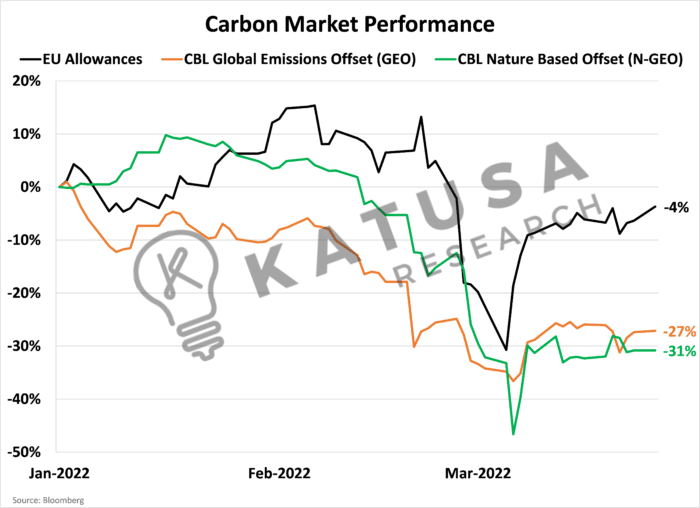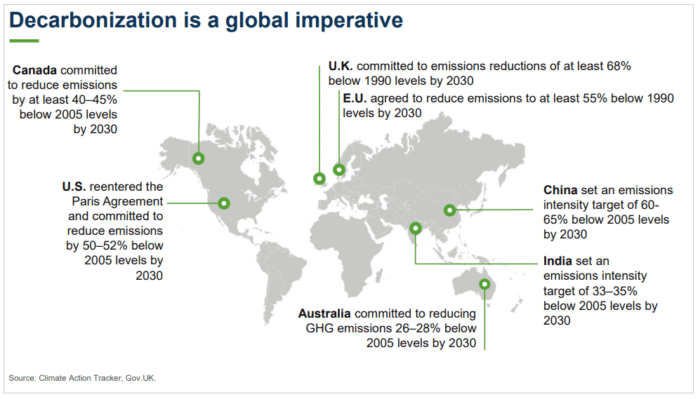There are major movements happening behind the scenes in the carbon markets.
You wouldn’t know it because of the recent price corrections of the EU ETS and Voluntary Markets (NGEO and GEO), caused by the Ukraine and Russia crisis.

While a calm breath was needed from fast price spikes (especially in the EU market)…
I’ve never in my career seen a coordinated regulatory framework accelerating at this pace between world governments and major corporations.
Carbon Markets are Moving FAST
Secretary of the SEC – Gary Gensler – recently made a major announcement that his department is looking at climate disclosures.
With new guidelines potentially coming this year and, in his words, “It’s essential we get this right.”
- I don’t think 99.99% of investors understand how this could have a massive ripple effect on every single publicly listed stock in North America.
Companies will have to create new departments to deal with coming “Climate Accounting” in their financial statements.
And it’s coming quicker than you think.
According to The Washington Post…
“Under a ground-breaking new rule, the SEC is expected to propose… hundreds of businesses would be required to measure and disclose greenhouse gas emissions in a standardized way for the first time.”
The article goes on to reveal…
“The move could mark the most sweeping overhaul of corporate disclosure rules in more than a decade, and could put the United States on a closer footing with other countries set to begin mandated emissions reporting over the next three years.”
Tick. Tock.
The alarm is set.
Fortunately at Katusa Research, we’ve prepared for this over the last 18 months.
But, I must say, that I’m shocked at how fast things are changing and getting implemented.
We’ve modeled many major commodity companies in the energy and metal sectors and what the effect of showing Scope 1 and 2 emissions will be on their bottom line.
Some companies will be fine, and others will be in big trouble.
From ‘Barley to Bar’
Major tech darling companies like Tesla, Facebook, Apple, and Microsoft aren’t out of the woods either. However, they’re much more ahead of the game than many resource companies. Tesla recently announced its carbon credit sales jump by 116% to $679 million.
They’ve outlined net-zero plans and spent a lot of capital.
- For example, in 2021, Apple set aside a $200 million fund for reforestation projects.
The Restore fund will focus on managed forest properties, in which tree-planting activities will become equal to the estimated lifetime carbon emissions produced from charging iPhones.
Like Apple, Microsoft is also aiming to recruit the help of its suppliers and customers through a climate innovation fund valued at over $471 million.
The fund will help the company improve its global development technologies to streamline reducing, capturing, and removing carbon.
Most of the carbon emissions produced by the company come from indirect carbon emissions commonly associated with the manufacturing and the production of its products.
- In 2021, Microsoft emitted 14 million metric tons of carbon, and 13.8 million of it came from indirect carbon emissions.
Even liquor giant Heineken is not immune…
One of the largest liquor companies in the world, Heineken set an intermediate goal to reach net-zero emissions in production by 2030. And reduce their value chain by 30%.
Their plan is called “Brew a Better World… From Barley to Bar”.

First, The Storm
According to the Glasgow Financial Alliance for Net Zero (GFANZ), $130 trillion has been mobilized for net-zero targets around the world.
That’s a mind-boggling number…
Nearly $16,250 per living person on the planet today.
These are staggering figures.
- Decarbonization is a global movement that governments, companies, and individuals around the world are buying into.
These days it is nearly impossible to find an asset class that is not already widely available for purchase, sale, or consumption worldwide.
Markets these days are deep, well-integrated, and for the most part highly efficient. That wasn’t always the case though.
Rewind to History
In 1611, the Dutch East India Company became the first publicly-traded company on the Amsterdam exchange.
In the late 1700s, merchants would gather to sell securities in New York, initiating the creation of the New York Stock Exchange.
Soft commodities like rice, grains, and salt along with gold and silver have been bought, sold, and traded in markets for centuries. Oil started small also.
Oil is now a multi-trillion dollar a year market.
- I believe that the voluntary carbon market has the ability to grow from a sprouting $1 billion market to a $5-$10 billion market or more, over the coming decade.
Now… could you imagine being a part of the oil trade in its early years?
This is the stage I believe the carbon markets are at right now.
The Next 24 Months Will See Incredible Sector Growth
The adoption curve is real.
- Network effects are already in play with hundreds of public companies announcing their net-zero plans.
The rules, regulations, opportunities, and pitfalls are being created before our very eyes today.
If you don’t understand the market, the players involved and the direction the market is going, you could lose your shirt, house, and everything else.
That said, newly created sectors also generate enormous opportunities to create wealth.
With any new commodity or sector, thousands of rounders will crop up overnight.
Hundreds of legitimate companies will spring up, too. Only a small handful will actually make it to the big time.
10 percent of your investments make 90 percent of your gains.
What if you knew which 10 percent those were—and you could put money into them?
Franco-Nevada and Silver Wheaton were the two set-it-and-forget-it gold stocks in the early 2000s, owing entirely to their streaming and royalty business model.
And I think I’ve found the next Franco and Silver Wheaton in the carbon sector.
Subscribers to Katusa’s Resource Opportunities know exactly what I’m talking about.
We’re early. Very early.
This is going to be a wild ride.
Regards,
Marin



